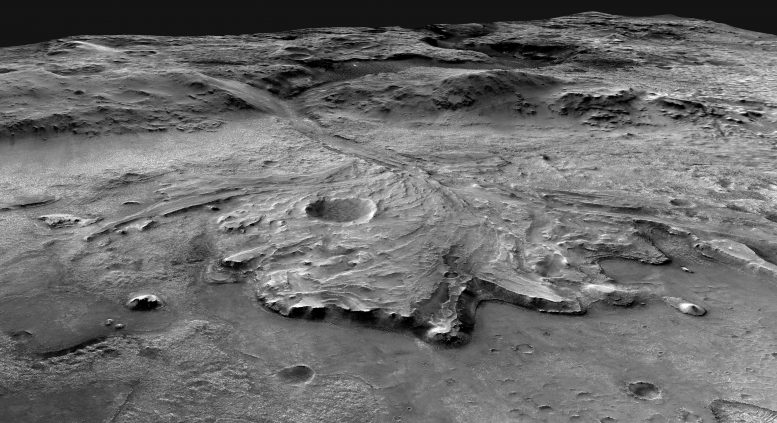
Description: This oblique view looks to the west from above the Jezero crater floor, over the fan-shaped delta deposit, and into the valley that cuts through the crater rim. The Perseverance Mars rover will land near this delta to search for evidence of past life and collect samples that could be returned to Earth by a later mission. Deltas form when flowing water is slowed down by encountering standing water, causing sediment to be deposited. On Earth, deltas are excellent at concentrating and preserving evidence of life, making this delta on Mars an appealing target. The Mars 2020 spacecraft will carry the same image mosaic used to generate the view shown here onboard and use it to steer itself away from hazards on the surface such as cliffs and dune fields. The seamless mosaic is composed of multiple precisely aligned images from the Context Camera on the Mars Reconnaissance Orbiter, and has a resolution of 6 meters per pixel. The large crater on the delta has a diameter of roughly 1km. Credit: NASA/MSSS/USGS
When you’re planning to explore someplace new, it’s always a good idea to bring a map so you can avoid dangerous terrain. This is true whether you’re heading out for a hike on Earth or you’re landing a rover on Mars.
When NASA’s Perseverance rover lands on Mars next year, it will be equipped with some of the most precise maps of Mars ever created, courtesy of the USGS Astrogeology Science Center. Not only are the new maps essential for a safe landing on Mars, but they also serve as the foundation upon which the science activities planned for the Mars mission will be built.
“Exploration is part of human nature and USGS has a long history and enduring interest in researching planets other than our own,” said USGS director and former NASA astronaut Jim Reilly. “These maps will help the Perseverance mission unlock the mysteries of the red planet’s past and guide future missions.”
This video highlights two mosaics of the Jezero crater landing site on Mars made by the USGS Astrogeology Science Center to support the Mars 2020 mission, as well as several key locations that the Perseverance rover may visit once it is on the surface. The larger mosaic is composed of images from the Context Camera on the Mars Reconnaissance Orbiter. The higher-resolution mosaic is composed of images from the HiRISE (High Resolution Imaging Science Experiment) camera on the Mars Reconnaissance Orbiter. In both mosaics, the images were aligned to each other and to the planet with unprecedented precision. The high-resolution mosaic was used to identify hazards in the landing ellipse. The resulting hazard map and the CTX mosaic will be carried onboard the spacecraft, which will use them to steer away from hazards as it lands.
Perseverance is expected to launch this week. The mission’s goals are to search for evidence of past life and habitable environments in Jezero crater and collect and store samples that, for the first time in history, could be returned to Earth by a future mission.
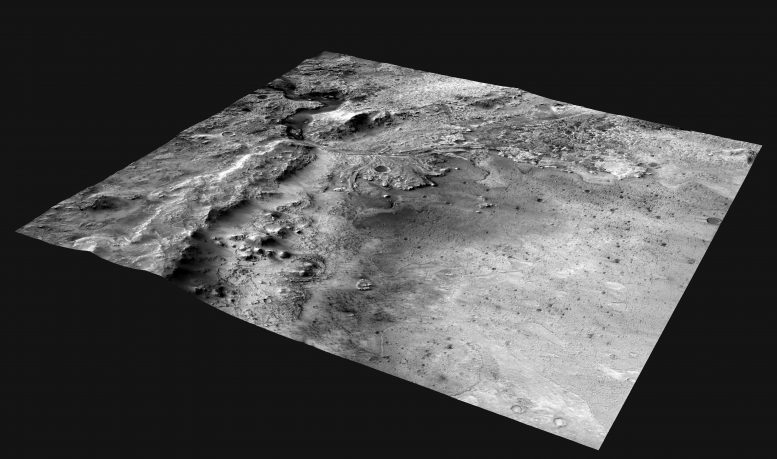
Oblique view looking toward the northwest shows the western rim and floor of Jezero crater, Mars. Credit: NASA/MSSS/USGS
To safely land on the rugged Martian landscape, the spacecraft will use a new technology called “Terrain Relative Navigation.” As it descends through the planet’s atmosphere, the spacecraft will use its onboard maps to know precisely where it is and avoid hazards. For the navigation to work, the spacecraft needs the best possible maps of the landing site and surrounding terrain.
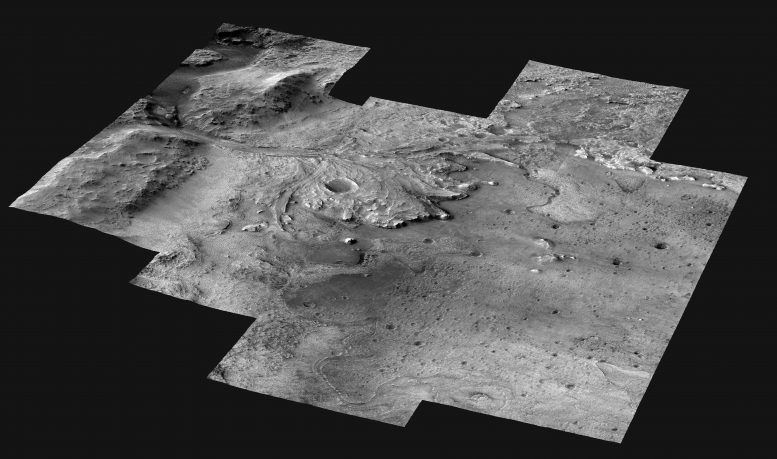
Oblique view looking toward the northwest shows the location where a river valley cuts through the rim of Jezero crater and ends in a fan-shaped delta deposit. Credit: NASA/MSSS/USGS
“As much as we would love to manually steer the spacecraft as it lands, that’s just not possible,” said Robin Fergason, USGS research geophysicist. “Mars is so far away — some 130 million miles at the time of landing — that it takes several minutes for radio signals to travel between Mars and Earth. By using the maps we created, the spacecraft will be able to safely steer itself instead.”
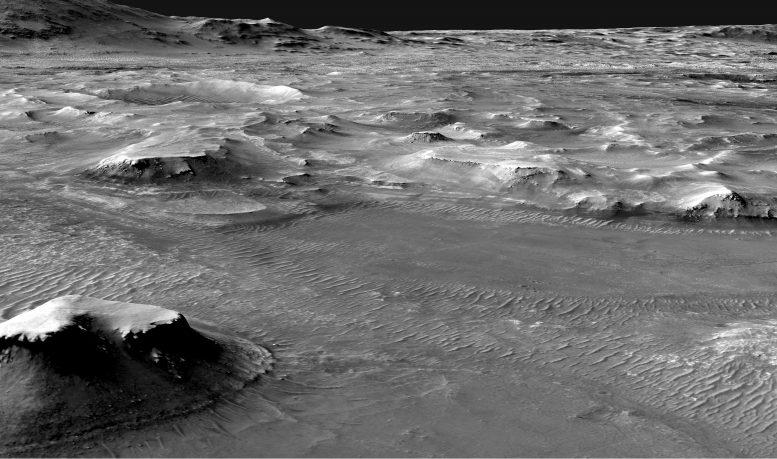
High-resolution oblique view of the southern edge of the delta deposit in Jezero crater, the landing site for the Perseverance Mars rover. Credit: NASA/MSSS/USGS
The USGS developed two new maps for the Mars mission. The first is a high-resolution (25-cm per pixel) map that researchers have used to accurately map surface hazards at the landing site. This map will serve as the base map for mission operations and to plot where the rover will explore after landing. The second map is a lower resolution (6-meters per pixel) map that spans the landing site and much of the surrounding terrain. This will be used onboard the spacecraft, along with the locations of the hazards from the high-resolution map, to help it land safely. The maps have been aligned with unprecedented precision to each other and to global maps of Mars to ensure that the maps show the hazards exactly where they really are.
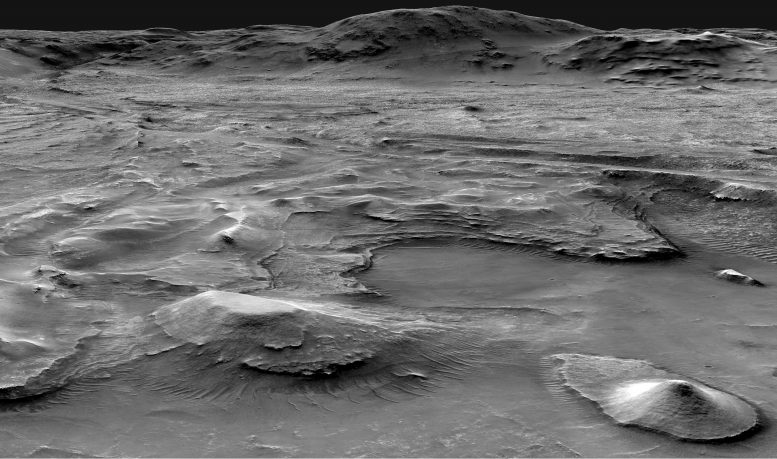
High-resolution oblique view of the northeastern edge of the delta deposit in Jezero crater, the landing site for the Perseverance Mars rover. Credit: NASA/MSSS/USGS
The new maps are based on images collected by the Mars Reconnaissance Orbiter’s Context Camera and the High-Resolution Imaging Science Experiment (HiRISE) camera.
When you’re planning to explore someplace new, it’s always a good idea to bring a map so you can avoid dangerous terrain. This is true whether you’re heading out for a hike on Earth or you’re landing a rover on Mars! When NASA’s Perseverance rover lands on Mars in 2021, it will be equipped with the most precise maps of Mars ever created, courtesy of the USGS Astrogeology Science Center.
Safe Landing
USGS maps will help the Mars 2020 spacecraft steer itself to a safe landing near an ancient river delta, the ideal spot to search for evidence of past life.
Guide Rover Exploration
The Perseverance rover will help unlock the mysteries of the red planet’s history and guide future missions. USGS created this high-precision map of the Mars 2020 landing site in Jezero crater, continuing our long history of helping to explore our solar system.

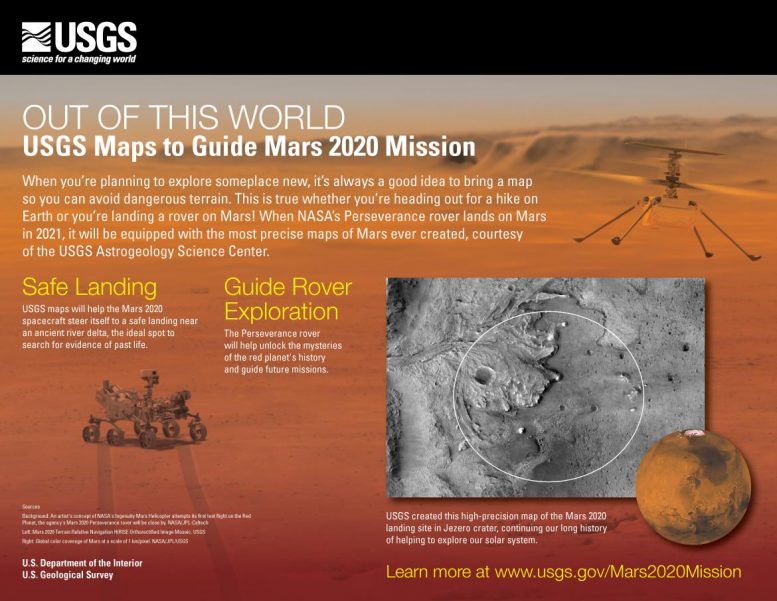


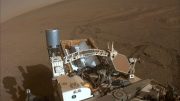
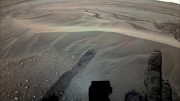
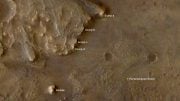
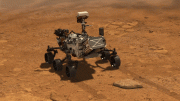
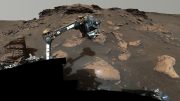
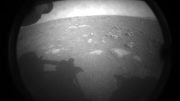
Life is what happens to us while we are making other plans.
As long it’s to save the planet from coming doom am okay but this seems quite too much, let’s not forget that we were not born on Mars